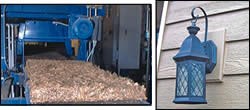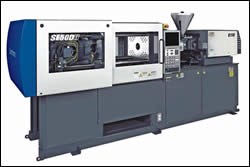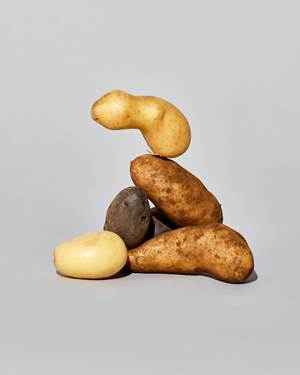Wood-Plastic Composites: Weathering Quality Issues
Exterior wood-fiber composites like decks and rails haven't lived up to some of the early claims of long, maintenance-free life.
Exterior wood-fiber composites like decks and rails haven't lived up to some of the early claims of long, maintenance-free life. In fact, composite decks with high wood loadings can shrink, expand, stain, warp, split, and fade much like natural wood. They can also grow mold and sprout mushrooms, be eroded by water, and eaten by termites.
Who knew? Not the wood-plastic composite (WPC) manufacturers because the materials were too new on the market. Outdoor applications for wood and natural-fiber composites grew in 10 to 15 years from zero to over 2 billion lb/yr with little or no statistical data or test methodology to study the effects of weather and aging.
Such test data are only recently becoming available through a series of technical conferences. A particularly noteworthy example was the 8th Woodfiber-Plastic Composites Conference in Madison, Wis., sponsored in May by the USDA Forest Products Laboratory in Madison and the Univ. of Toronto. "There were several excellent papers describing new test results and comparing real-world moisture aging tests with lab results," says Tatyana Samoylova, R&D engineer with decking manufacturer Kadant Composites in Bedford, Mass. "This is what the industry needs."
Another big need for makers of wood and natural-fiber composites is to expand into new markets beyond decking. The focus of the 4th WPC Conference held last October in Baltimore by Principia Partners was on new product development, especially ones made via injection molding, the newest and smallest composite process. (The 5th WPC Conference next month will have a similar emphasis.)
Meanwhile, the 2nd Wood Fibre Polymer Composites Conference last March in Bordeaux, France, focused on construction applications, new process technologies, and advanced performance standards. This new triennial conference is sponsored by the CTBA (Centre Technique du Bois et de l'Ameublement) in Bordeaux.
In the U.S., ASTM has developed the first quality standards in the world for wood-composite decking. ASTM D 7031, a compendium of test methods, was approved in 2004 as a guide for makers of WPCs. This year saw publication of ASTM D 7032, which sets physical specifications for building-code acceptance of WPC deck boards and guard rails. Ongoing work at ASTM is focused on standards that will expand the use of wood and natural-fiber composites into more sophisticated construction applications. Work in Europe is also addressing issues of aging and weatherability, including the need for tests of water absorption, weight loss, weatherability, aging, color fastness, and resistance to fungi, algae and insects, according to Gilles Labat, R&D manager of CTBA.
Stakes are high in a global market for wood and natural-fiber composites that Principia estimated at 1.7 billion lb in 2003 and says this year could be as high as 2.1 billion lb, assuming 15% annual growth. The U.S. market is close to 85% of that total, says Principia senior partner James Morton.
Hence the keen interest in weathering test methods and results. Most of all, recent data show how complex the interactions are among wood-fiber type and length, fiber combinations, colorants, coupling agents, lubricants, and other additives. There is nothing simple or predictable about the way ingredients in a wood composite behave. And it seems they all have some effect on weathering, moisture aging, fungi, and color loss.
Worlds apart
Markets and technologies for wood and natural-fiber composites are very different in North America and in Europe. Half the North American market is decking or deck-related components, and most of the rest is also extruded profiles—from marine pilings to pencils. There is some compression molding of automotive and construction parts. Injection molding accounts for a very small fraction. Most composites here use wood fiber, rarely over 50% loading, and there is only limited use of agricultural fibers.
In Europe, wood and natural-fiber composites are far more varied and technically advanced. The big market is automotive parts, both injection and compression molded, consuming 350 million lb in 2003, the most recent year studied by the Nova-Institut in Germany. Other big markets in Europe are flat panels for furniture and cabinetry. Europeans use predominantly agricultural fibers like sisal, kenaf, flax, hemp, jute, cotton, and comparatively little wood fiber. European fiber loadings can also be much higher—70% to 85% (up to 50% in auto parts).
Belt methods for panels
New processes introduced at two recent conferences make flat panels from wood composites without extrusion. Pallmann Maschinenfabrik (German parent of Pallmann Pulverizers in the U.S.) is working with Schilling-Knobel GmbH in Germany on a dual-belt wood-composite process that was presented at the CTBA conference in France. In this process, Pallmann's Palltruder first pelletizes wood flour or fiber and virgin or recycled HDPE. The pellets, called Pallwood, are then scattered onto the lower belt of a PFIX heated double-belt forming press from Schilling-Knobel (typically used to make PVC flooring). Schilling-Knobel is doing development work in wood composites for a large U.S. laminating company and other clients worldwide. Its dual-belt line was tested making 60%-wood granules into sheet up to 2 meters wide and 8 to 10 mm thick.
At Principia's WPC conference last year, Verset Technologies Inc. introduced another heated-belt technology to mold flat parts like siding. Developed over the past 10 years, Verset's patented Pressaire process uses a modified version of equipment like that used to press chip board in the lumber industry. It was installed in 2003 in a dedicated Boise Cascade plant in Elma, Wash., to make siding panels, but because of restructuring at Boise Cascade, the siding hasn't been commercialized.
Verset's process starts by mixing recycled PE film with undried wood slivers or flakes at room temperature. Hot air is then forced through the mix, melting the plastic in about a minute. This mix starts about 7 in. thick and after heating collapses into a hot mat 2 to 3 in. thick. The hot mat is transferred via belts to a cold press, which forms it into a flat panel 0.25 to 0.75 in. thick with molded-in woodgrain. The siding is subsequently primed for painting. The in-line process at Boise Cascade is set up to run continuously.
First fiber database
To help in wood-plastic product development, M-Base Engineering + Software in Germany has created the first database of properties of natural fibers and plastic compounds containing these fibers. Called N-FibreBase, it is available free in three languages at www.N-FibreBase.net. It was introduced in 2004 and presented at the Madison conference last May.
N-FibreBase provides standardized test data for different natural fibers, including type of fiber, producer, trade name, fiber size, length, strength, stiffness, color, odor, and fogging potential. It identifies moisture absorption and strength in different formats—i.e., as non-wovens or in plastic compounds—as well as place and method of cultivation, fiber separation method, and surface treatment. M-Base is represented in the U.S. by the Madison Group.
Fiber data were also presented in Madison by STFI-Packforsk AB, a Swedish research institute for the paper industry. STFI tested thermoset vinyl ester composites made by RTM using isotropic and oriented-fiber mats made of different types of wood fibers. STFI found that unbleached fibers and hardwood fibers make better stiffeners than bleached fibers and softwoods.
Optimized fiber mixtures
Structural composites are being optimized for higher properties with combinations of different fibers and fibers plus mineral fillers. Using wood flour with other fibers has been done for years, such as wood-filled and glass-reinforced marine pilings. Some decking and shingle products also combine natural fibers like rice hulls (which absorb little water) with wood fiber, minerals, and other fillers.
CreaFill Fibers Corp., a supplier of cellulose fibers, reported in Madison on development of a composite prepreg made out of 60% cellulose fiber with 40% PTT (polytrimethylene terephthalate) fiber (DuPont's Sorona carpet fiber). The prepregs are made by a wet-laid paper-making process and then consolidated in a hot press, which melts the PTT to wet out the cellulose. A potential target is high-strength flat panels.
Cellulose fibers, which are flat and ribbonlike, significantly improve impact and flex modulus, CreaFill says. Fibers from kraft paper are 1 to 2 microns thick, 30 microns wide, and 500 to 5000 microns long. Fibers from newsprint are 1 to 2 microns thick, 64 microns in average width, and 1717 microns in average length.
PTT makes it possible to compression mold cellulose without thermally degrading it because PTT's melt temperature at 437 F is so much lower than PET's (490 F). PTT fibers are also made from Shell's Corterra resin, which costs only slightly more than PET.
CreaFill tested prepregs with 60% cellulose from newsprint or kraft paper and 40% PTT fiber. Also tested were mixtures of 15% PET fiber/40% PTT fiber/45% kraft cellulose and 30% PET/40% PTT/30% kraft cellulose. Adding PET raises the ultimate elongation by up to 27% and boosts impact strength as well.
CreaFill offers a low-cost cellulose fiber made from newsprint (grade TC 1004) for 20¢/lb. Average fiber length is 850 microns, which is long for newsprint-derived cellulose. TC 1004 was used in tests for Ford Motor Co. Adding 10% talc and 30% recycled newsprint cellulose to a biodegradable resin matrix of PLA (polylactic acid) raised flexural strength and modulus compared with cellulose fiber alone. Flexural strength was 94 MPa for PLA with cellulose plus talc vs. 77 MPa with just cellulose. Flex modulus was 10.8 MPa with cellulose and talc vs. 6.7 MPa with only cellulose. Silane-treated talc (such as Luzenac's Mistron CB) further boosted properties significantly.
Wood fiber in foam
Additives, lubricants, fillers, and the type and size of fiber all affect stiffness, weatherability, water absorption, and the color fastness of composites, but the interactions are complex and often unexpected. The size of wood fibers, for example, affects the ability to create fine-celled foams, reported the Microcellular Plastics Manufacturing Lab of the Univ. of Toronto at the Madison conference.
The university foamed HDPE composites with CO2 and used three size ranges of wood fibers from 120 to 200 mesh (25 to 125 micron particles) to 20 to 60 mesh (250 to 850 microns). The smallest fibers were expected to produce the highest melt viscosity, since their surface area was the largest. But they didn't. Instead, the mid-sized fibers gave the highest viscosity. Researchers suggest that possibly the larger surface area of small fibers allows them to release more volatiles, which helps lower the viscosity. However, smaller wood fibers make for a finer cell structure—possibly because the small fibers do more to enhance nucleation.
Impact modifiers accelerate the rate of gas loss when foaming wood-PVC composites with CO2 in a batch process, according to a report at the Madison conference by the Michigan State University Dept. of Forestry in East Lansing. Impact modifiers also inhibit volume expansion. (Roughly 20% of wood composites are foamed, most of them based on PVC.)
Weathering forecast
It's hard enough to predict the weather, but anticipating the response of wood fibers to weathering is even trickier. Two weatherability aging studies presented in Madison compared standard lab-test conditions for moisture absorption with either natural or simulated weathering and found some puzzling and surprising results.
The USDA Forest Products Lab tested the effects of uv light combined with water spray on 50% wood-filled HDPE injection molded samples. It found that uv plus water spray did far more damage to wood composites than uv or water immersion separately.
Exposure to the standard ASTM test regimen of 3000 cycles of uv light and water spray—each cycle involving 102 min of uv followed by 18 min of uv with water spray—left the test composite 87% lighter in color. The same number of cycles of uv alone for 2 hr/cycle lightened color only about 28%. Color change from soaking in water alone also was much less than with uv/water spray. Density of the composite also dropped from 1.08 to 1.05 g/cc with uv plus water, while uv alone decreased density only to 1.07 g/cc. The composite board also got thinner after exposure to uv and water spray, whereas uv alone didn't alter thickness. The study concluded that uv with water actually washes away a layer of lignin and degraded wood.
At that meeting, Epoch Composite Products in Lamar, Mo., discussed preliminary (12-month) test results from an ongoing weatherability study comparing the effects of natural and accelerated aging on the color fastness of its EverGrain compression molded decking (50% wood flour in polyolefin). Epoch compared natural weathering for eight months (ASTM G7) with xenon-arc accelerated weathering for 1200 hr (ASTM G155). Tests involved two decking colors, redwood and cedar, standard colorants vs. specially concentrated pigments, mixed-metal-oxide inorganic pigments, and pigments plus antioxidant and uv stabilizer.
Epoch's initial findings were that concentrated color pigment improved weathering and color fastness. UV/antioxidant stabilization didn't prevent color change, but did improve surface integrity and weatherability. Mixed-metal oxide pigments did not improve color fastness at all. Preliminary data also indicated that coloring the wood flour before compounding improved color fastness only with cedar color, not with redwood. Use of reprocessed HDPE caused surface degradation, but did not affect weathering of colors.
Research also has revealed a large discrepancy between water absorption in natural outdoor exposure and water absorption in a standard ASTM lab test. Marek Gnatowski, research director at Canadian plastics consulting firm Polymer Engineering Co., reported in Madison that decking samples absorbed only about 1% moisture in a 24-hr soak according to ASTM D1037. But they absorbed at least 15% water when exposed to outdoor weathering for 21 months.
Overall moisture content of a wood-composite deck board is usually claimed to be less than 2%. However, material at the board ends and 1 to 7 mm below the board surface "frequently exceeds 25% moisture," Gnatowski notes. That 25% moisture is an open invitation for fungi to attack wood-plastic composites. Higher wood content increases the depth of this highly moisture-laden surface zone. Gnatowski found that adding zinc borate as a biocide to the decking compound reduces water absorption as well. "That function was unknown and unexpected," he adds.
Research on the durability of wood-HDPE composites under accelerated freeze-thaw cycles was also presented in Madison by Michigan State's Forestry Dept. Freezing and thawing causes significant loss of stiffness, which can be prevented with 2% addition of a coupling agent.
Mushrooming problem
Research reported in Madison by the University of Guadalajara, Mexico, in cooperation with Oregon State University in Corvalis showed that under the right circumstances, fungi can eat away more than just the surface of a composite containing over 50% wood. Very thin sample boards were smeared with agar, a gel used in laboratories as a microbial growth medium. Those samples were inoculated with different types of fungi and kept moist for 12 weeks' incubation. Another test method, called the soil block test (ASTM D1413), involves exposing a sample of decking to moist soil for a period of time. While these methods may not sound like real-world conditions for wood-plastic decking, local accumulations of leaves and dirt can do much the same thing. Sample boards exposed to agar showed as much as 10% to 25% weight loss and those exposed to soil lost 12% to 18%.
Moisture content of the composites soared to 65% to 95% during those tests. More than 25% moisture in a 2-micron-thick surface region of a wood composite is enough to cause mildew after 12 weeks, reported Beologic nv of Belgium at the Madison conference. Beologic is a five-year-old producer of wood-filled plastic pellets in PP, PE, PS, and PVC. It found two factors to be effective in minimizing fungal growth: use of a fungicide and use of longer wood fibers.
Higher lubricant content contributes to mold growth, reported the School of Forest Resources of Michigan Technical Univ., Houghton, at the Madision conference. Mold growth can be inhibited with biocides such as 2% to 5% zinc borate or 1% to 1.5% chlorothalonil.
One recent finding is that low levels of coupling agents can improve surface resistance to moisture so much that mildew is no longer a problem. Even very low levels (0.5%) of an anhydride-functional polyolefin coupling agent such as DuPont's Fusabond can reduce water absorption dramatically, DuPont reports. "I thought a coupling agent was for better properties," says a person formerly involved in selling coupling agents for wood composites. "But now they're using it for moisture resistance.
Related Content
Resins & Additives for Sustainability in Vehicles, Electronics, Packaging & Medical
Material suppliers have been stepping up with resins and additives for the ‘circular economy,’ ranging from mechanically or chemically recycled to biobased content.
Read MoreCling Wrap Made from Potato Waste
Australia’s Great Wrap to expand into U.S. with home compostable cling wrap and its refillable dispenser made from recycled PET bottles.
Read MoreWhy Are They Blending Biopolymers?
A sit-down with bioplastic producer Danimer Scientific showed me there are more possible answers to that question than I had previously thought.
Read MoreHow to Extrusion Blow Mold PHA/PLA Blends
You need to pay attention to the inherent characteristics of biopolymers PHA/PLA materials when setting process parameters to realize better and more consistent outcomes.
Read MoreRead Next
Processor Turns to AI to Help Keep Machines Humming
At captive processor McConkey, a new generation of artificial intelligence models, highlighted by ChatGPT, is helping it wade through the shortage of skilled labor and keep its production lines churning out good parts.
Read MoreTroubleshooting Screw and Barrel Wear in Extrusion
Extruder screws and barrels will wear over time. If you are seeing a reduction in specific rate and higher discharge temperatures, wear is the likely culprit.
Read MoreUnderstanding Melting in Single-Screw Extruders
You can better visualize the melting process by “flipping” the observation point so that the barrel appears to be turning clockwise around a stationary screw.
Read More















.png;maxWidth=300;quality=90)

















